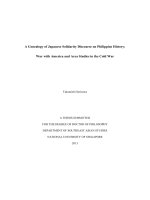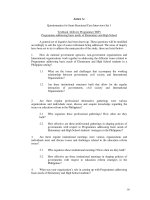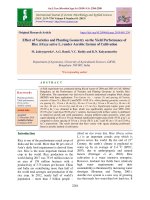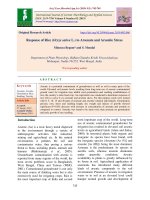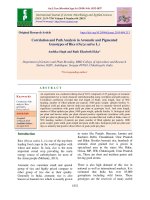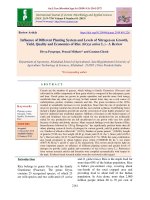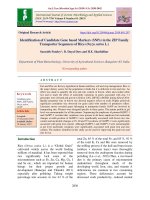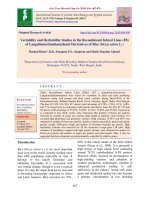Variability and heritability studies in the recombinant inbred lines (F8) of Langulmota/Sambamahsuri derivatives of rice (Oryza sativa L.)
Bạn đang xem bản rút gọn của tài liệu. Xem và tải ngay bản đầy đủ của tài liệu tại đây (559.27 KB, 10 trang )
Int.J.Curr.Microbiol.App.Sci (2019) 8(4): 467-476
International Journal of Current Microbiology and Applied Sciences
ISSN: 2319-7706 Volume 8 Number 04 (2019)
Journal homepage:
Original Research Article
/>
Variability and Heritability Studies in the Recombinant Inbred Lines (F8)
of Langulmota/Sambamahsuri Derivatives of Rice (Oryza sativa L.)
Rashad Khan*, B.K. Senapati, P.L. Sangeeta and Shaik Shamim Ahmed
1
Department of Genetics and Plant Breeding, Bidhan Chandra KrishiViswavidyalaya,
Mohanpur-741252, Nadia, West Bengal, India
*Corresponding author
ABSTRACT
Keywords
Recombinant inbred
lines, Variability,
Heritability,
Genetic advance
Article Info
Accepted:
07 March 2019
Available Online:
10 April 2019
Thirty Recombinant Inbred Lines (RILs) of F 8 generation derived from
Langulmota/Sambamahsuri were tested for variability of yield and yield attributing
characters along with parents and three check varieties during kharif-2016, at the
Instructional farm, Bidhan Chandra Krishi Viswa Vidyalya, Jaguli, Nadia, West Bengal.
The lines S2, S28, S10, S24, S17 shown yield advantage of 4.78%, 4.58%, 4.1%, 3.48%,
and 2.7% respectively as compared to both parents and checks. Lines S2, S10, S17, S5 and
S3 shown yield advantage of 35.83%, 34.94%, 33.12%, 32.94% and 32.59% respectively
as compared to best check variety only. Characters like number of florets per panicle,
followed by number of grains per panicle, plant height at maturity, floret fertility (%)
recorded high phenotypic and genotypic variance. High estimates of PCV and GCV was
obtained for number of florets per panicle, number of grains per panicle, panicles per plant,
panicle weight, 1000 grain weight and number of secondary branches per panicle. High
heritability estimate was observed for all the characters except grain L/B ratio. High
estimates of heritability coupled with high genetic advance were obtained for number of
florets per panicle and number of grains per panicle and plant height. Thus, it may be
suggested that these characters are predominantly controlled by additive genes.
60% of the caloric intake of the three billion
Asians (Guyer et al., 1998). It is primarily a
high energy or high caloric food containing
around 78.2% carbohydrates, 6.8% protein.
Research efforts focused on development of
high-yielding varieties and adoption of
modern production technologies resulted in
enhanced production leading to selfsufficiency in the country. Along with yield,
grain and nutritional quality has also become
a primary consideration in rice breeding
Introduction
Rice (Oryza sativa L.) is the most important
food crop in the world, directly feeding more
than 60% population especially in Asia. It
belongs to the family Graminae and
subfamily Oryzoidae. It is associated with
wet, humid climate, though it is not a tropical
plant. It is also the staple food across Asia and
is becoming increasingly important in Africa
and Latin America. Rice accounts for 35%467
Int.J.Curr.Microbiol.App.Sci (2019) 8(4): 467-476
programs not only in India but also in various
rice growing countries across the world. The
strategy in the present agriculture is to
produce adequate quantity of food from the
available acreage to meet the requirement of
ever expanding world population. Population
of Recombinant Inbred Lines (RILs) can
serve as a powerful tool to cover the
complexity of yield related traits. They are the
recombinant output from which superior
stabilized segregants can be directly used as
breeding lines. The present study is therefore
an attempt to characterize RIL population and
find out superior genotypes of rice suitable for
the Gangetic plains of West Bengal by
assessing the RILs of Langulmota/
Sambamahsuri derivatives understand the
differences among the rice varieties with
respect to yield and its attributing characters.
the 19 characters namely
Days to 50%
flowering, Days to maturity, Plant height
(cm), Number of panicles per plant, Panicle
weight (g), Panicle length (cm), Number of
primary branch per panicle, Number of
secondary branch per panicle, Number of
florets per panicle, Number of grains per
panicle, Florets fertility (%),1000 grain
weight (g), Grain length (mm), Grain breadth
(mm), Grain L/B ratio, Kernel length (mm),
Kernel breadth (mm), kernel L/B ratio, Grain
yield per plant. The genetic parameters were
estimated based on the method suggested by
Al Jibouri et al., (1958) and Johnson et al.,
(1955). The statistical analysis was done
using the software OPSTAT.
Results and Discussion
Analysis of variance (ANOVA) revealed
significance differences among all the rice
genotypes against all of the characters studied
(Table 1). Thus, there is a potential for
improving these traits through precise
selection.
Materials and Methods
The experimental materials consisted of 30 F8
progenies developed from Langulmota/
Sambamahsuri derivatives at Regional
Research Station, new alluvial zone, sub
center- Chakdah, Nadia. Along with two
parents and three check varieties viz.,
Dhanrasi,
SwarnaSub-1,
Sabita.The
experiment
was
conducted
during
Aman(Kharif) season of year 2015-16 at
Instructional farm, Bidhan Chandra Krishi
Viswavidyalya, Jaguli, Nadia, West Bengal.
The experimental field is situated at latitude23⁰ 5’N, longitude 88⁰59’ E and altitude of
9.75 m ( above mean sea level) in New
Alluvial Zone of West Bengal, India.The
experiment was conducted in Randomized
Block Design with two replications. The
seedlings were transplanted at a spacing of
20cm from row to row and 15cm from plant
to plant and recommended agronomic
package of practices were followed during the
crop growth period. The observations were
recorded from five randomly selected plants
from each replication for each genotype for
Mean performance of 19 quantitative traits in
30 RILs of Langulmota/Sambamahsuri
derivatives along with parents and check
varieties i.e. Sabita, Dhanrasi and Swarna
Sub-1 respectively are presented in table 2.1
and 2.2. Wide ranges of variability were
found for days to 50% flowering among the
genotypes. It varied from 99.00 to 121.00
days i.e., days after sowing (DAS). The
earliest days to 50% flowering observed in S22
(99.0 DAS).Days to maturity varied from
130.5 to 151.0 days. Earliest maturity was
recorded forS22 (130.5 DAS), followed by S30
(134.5 DAS), S17 (134.5 DAS). The Plant
height among the genotypes varied widely. It
ranged from 69.0 to 163.5 cm. The number of
panicle per plant ranged from 5.0 to 13.0. The
maximum number of panicles per plant was
observed in S28 (13) followed by S24 (11.5),
Swarna Sub-1(11.5), S18 ( 11.5), and the
468
Int.J.Curr.Microbiol.App.Sci (2019) 8(4): 467-476
panicle weight ranged from 1.31 to 4.74g.
Highest panicle weight was recorded in
Langulmota (5.11g) followed by S13 (4.74g),
S10 (4.74g), S21 (3.43g).
34.94%, 33.12%, 32.94%, and 32.59%
respectively as compared to best check
variety. The lowest grain yield per plant was
recorded against S14 (13.37g) followed by S8
(15.97g) and S20 (16.73g).
S21 recorded maximum (14.56) number of
primary branches per panicle followed by S10
(13.16) and S20 (12.58). Number of florets per
panicle ranged from (96.30 to 420.29). The
highest number was recorded against S13
(420.29)
and
followed
by
S10
(358.12).Maximum number of grains per
panicle was recorded against the genotype S13
(236.30) followed by S10 (220.37) and S11
(186.5).S7 was found to have the maximum
florets fertility (86.43%) followed by S22
(85.72 %) and S28 ( 84.34%). Highest test
weight was recorded for Langulmota (30.76g)
followed by S6 (29.03 g) and Sabita (25.38 g).
The range for grain length varied from (6.08
to 9.87mm). Maximum length was observed
in the genotype S25 followed by Sabita(9.76
mm) and S30 (9.25 mm).The grain breadth
was found to be maximum in S6, and
Langulmota (3.09mm) followed by S27 (3.00
mm), and Sabita (2.90 mm). Highest grain
L/B ratio was recorded against S8 ( 4.41)
followed by S30 (4.32) and S22 (3.93).
Maximum kernel length was found in S30
(7.78 mm) followed by S8 (6.84 mm), Sabita
(6.81 mm) and S18 (6.57 mm), while Dhanrasi
showed highest kernel breadth followed by
S21 and S26 (2.92 mm, 2.73 mm and 2.66 mm)
respectively. Highest kernel L/B ratio was
recorded by S8 (3.58) followed by Sabita
(3.51), S30 (3.23) and S25 (3.14).
The range, mean, genotypic, phenotypic and
environmental
variance,
Genotypic
coefficient of variation (GCV), Phenotypic
coefficient of variation (PCV), Heritability (in
broad sense), Genetic advance (GA) and
Genetic advance as percent of mean of 30
RILs
of
Langulmota/Sambamahsuri
derivatives, along with 3 check varieties of
rice and 2 parents are presented in Table 3. A
wide range of variability was observed among
the genotypes against all the characters
studied. This would offer a good scope of
selection for evolving promising desirable
genotypes. In general, phenotypic variance
was higher than the corresponding genotypic
variance against all the characters. The
genotypic coefficient of variation (GCV)
ranged between 3.22 (days to maturity) and
34.43(number of florets per panicle). The
phenotypic coefficient of variation (PCV)
ranged between 3.29 (days to maturity) and
35.98 (number of florets per panicle). Highest
estimates of genotypic and phenotypic
variance were observed for number of florets
per panicle, followed by number of grains per
panicle, plant height at maturity, floret
fertility (%), while It was also observed that
panicle weight, panicle length, grain length,
grain breadth, kernel breadth, kernel length,
grain L/B ratio and kernel L/B ratio showed
less genotypic and phenotypic variance.
A considerable degree of variation (13.34 to
30.63g) was observed for grain yield per plant
with a mean of 24.85g. S2 (30.63g) recorded
highest yield per plant followed by, S28
(30.57g), S10 (30.43g), S24 (30.25) and S17
(30.02g), with Yield advantage of 4.78%,
4.58%, 4.1%, 3.48%, 2.7% respectively as
compared to best parent. Line S2, S10, S17,
S5and S3 showed Yield Advantage of 35.83%,
The magnitude of PCV was higher than GCV
for all the traits studied, indicated that
environmental influences on the expression of
these traits. This observation was similar to
earlier findings of Abdourasmane et al.,
(2016), Mohan et al., (2016), Senapati and
Awneetkumar (2015), Akinwale et al.,
(2011). High estimates of PCV and GCV was
469
Int.J.Curr.Microbiol.App.Sci (2019) 8(4): 467-476
obtained for number of florets per panicle,
number of grains per panicle, panicles per
plant, panicle weight, 1000 grain weight and
number of secondary branches per panicle,
while, kernel L/B ratio, grain yield, number of
primary branches, panicle height, floret
fertility%, kernel length, grain breadth, grain
length. Kernel breadth exhibited moderate
GCV and PCV values (Table 3). Therefore,
there was a large scope for improvement of
these traits through precise selection and
hybridization.
These
findings
were
corroborated earlier by Ashok et al., ( 2013)
for number of panicles per plant, number of
florets per panicle, number of grains per
panicle, and panicle weight. By Malathi et al.,
(2015) for grain yield per plant. By
Madakemohekar et al., ( 2015) for number of
panicles per plant, and 1000 grain weight and
by Devi et al., (2017) for number of grains
per panicle.
was obtained for number of florets per
panicle, plant height, and number of grains
per panicle (Table 3). Lowest genetic advance
was obtained against grain breadth followed
by grain L/B ratio, kernel breadth, and kernel
L/B ratio. Comparable results were obtained
earlier, by Vijay et al., (2015) for number of
florets per panicle, Revathi et al., (2016) for
number of grains per panicle, and Anis et al.,
(2016) for plant height.
High estimates of heritability coupled with
high genetic advance were obtained for
number of florets per panicle, number of
grains per panicle and plant height. These
findings were similar with that of Vijay et al.,
(2015) for number of florets per plant. Similar
findings were reported by Revathi et al.,
(2016) for number of grains per panicle, and
Anis et al., (2016) for plant height.
High heritability along with high genetic
advance as per cent of mean was obtained,
number of florets per panicle, 1000 grain
weight, and floret fertility%, number of
secondary branches per panicle, plant height
and number of grains per panicle. This was in
agreement with the findings of Ashok Kumar
et al., ( 2013) for number of florets per
panicle, Gokulakrishnan et al., ( 2015) for
number of grains per panicle, Abdoursamne et
al.,(2016) for days to 50%flowering, and Devi
et al.,(2017) for plant height, 1000 grain
weight, it indicated the predominance of
additive gene action for controlling these
traits. Therefore, selection based on
phenotypic performance would be effective
for the improvement of these traits. High
heritability with moderate to low genetic
advance as percent of mean was observed for
days to 50% flowering, days to maturity,
number of primary branches per panicle grain
length, and kernel breadth which suggested
both additive and non-additive gene action for
controlling these traits.
Heritability ranged from 32.87% (number of
panicles per plant) to 95.70%(days to 50%
flowering). High heritability was recorded for
majority of the traits viz., days to 50%
flowering, plant height, kernel L/B ratio,
kernel length, grain length, grain yield per
plant, days to maturity, grain breadth, plant
height, number of florets, grains per panicle,
fertility%, 1000 grain weight, number of
primary branches per panicle, panicle weight,
number of secondary branches per panicle,
and kernel breadth. While grain breadth, grain
L/B ratio, number of panicles per plant, and
panicle length showed moderate heritability
(Table 3). These findings are accordance with
Rajamadhan et al., (2016) for plant height and
days to 50% flowering, Gupta et al., ( 2016)
for grain yield and 50% flowering, Devi et al.,
(2017) for plant height, grains per panicle,
1000 grain weight.
Genetic advance ranged from 0.31 (grain
breadth) to 135.85 (number of florets per
panicle). High estimate of genetic advance
470
Int.J.Curr.Microbiol.App.Sci (2019) 8(4): 467-476
Table.1 Analysis of variance for different characters of 30 RILs of Langulmota/Sambamahsuri derivatives along with parents and
check varieties of rice (Mean sum of square)
1
2
3
4
5
6
7
8
9
10
11
12
13
14
15
16
17
18
19
Days to 50 % maturity
Days to maturity
Plant height(cm)
No of panicles per plant
Panicle weight(g)
Panicle length(cm)
No.of primary branches per panicle
No.of secondary branches per panicle
Number of Florets per panicle
Number of grains/panicle
Floret fertility (%)
1000 grain weight(g)
Grain length(mm)
Grain breadth(mm)
Grain L/B ratio
Kernel length(mm)
Kernel breadth(mm)
Kernel L/B ratio
Yield/ plant(g)
d.f= Degrees of freedom Values given in Parenthesis
Source of variation with degrees of freedom(d.f.)
Replication(1)
Genotypes(34)
Error(34)
8.229
53.210**
1.170
0.514
43.738**
0.985
0.862
1035.077**
37.887
26.414
8.039*
4.061
0.123
1.248**
0.304
0.940
3.859*
1.944
0.036
3.256**
0.801
13.729
55.354**
10.761
1126.971
9939.881**
438.943
453.697
3023.059**
433.441
7.136
159.906**
20.222
1.094
34.351**
1.538
0.012
1.343**
0.068
0.015
0.132*
0.043
0.090
0.451**
0.005
0.033
0.878**
0.040
0.008
0.174*
0.036
0.004
0.405**
0.073
7.623
40.584**
2.466
** Significant at 1 % level of significance * Significant at 5% level of significance
471
Int.J.Curr.Microbiol.App.Sci (2019) 8(4): 467-476
472
141.14
179.05
172.14
148.90
162.25
138.07
83.40
100.80
148.00
220.37
186.50
180.50
236.3
123.19
182.50
145.57
167.75
93.30
97.84
102.19
72.33
74.80
72.40
71.25
83.94
82.55
86.43
70.30
55.07
61.43
66.18
74.65
60.05
54.12
67.69
74.17
74.56
61.85
74.64
71.84
16.37
15.26
15.12
14.35
16.06
29.03
13.04
21.19
15.03
17.86
16.49
14.83
16.68
16.01
14.52
16.77
16.88
18.48
16.01
21.09
8.49
7.95
8.15
8.35
8.24
8.27
7.47
9.77
7.98
7.80
7.42
7.66
7.04
8.11
6.55
8.27
8.14
8.73
8.42
6.08
Seed
yield / Plant
218.52
247.50
235.00
212.85
202.45
166.85
96.30
143.37
316.01
358.12
278.58
267.76
420.29
241.43
266.78
216.08
262.12
170.60
163.92
131.52
Kernel
L/B ratio
26.82
36.70
28.20
32.70
28.40
21.50
19.80
29.20
34.60
31.00
27.60
24.10
37.50
27.06
37.00
31.58
38.87
25.52
27.93
24.63
Kernel
breath (mm)
11.06
12.40
11.46
12.25
12.45
9.77
10.6
9.30
10.73
13.16
11.40
8.45
10.95
9.81
11.76
11.08
11.81
8.76
9.73
12.58
Kernel
length (mm)
19.90
22.80
22.42
21.38
22.14
21.55
22.08
23.32
23.34
21.55
23.24
19.31
23.05
19.53
22.43
21.75
22.97
23.30
19.67
23.70
Grain L/B
ratio
No. of Primary
branches/Panicle
2.93
3.54
3.28
2.84
2.97
3.49
1.31
2.63
3.19
4.74
3.17
3.17
4.74
2.54
3.06
2.82
3.64
1.90
2.70
2.47
Grain
breadth (mm)
Panicle
length(cm)
8.50
11.00
8.50
10.00
9.50
6.00
5.00
6.50
8.00
6.00
7.50
6.00
5.50
6.00
6.50
6.50
6.50
11.50
10.00
7.50
Grain
length (mm)
Panicle
weight(g)
145.50
154.50
150.50
148.00
140.00
140.50
121.0
137.00
139.00
145.50
145.50
134.50
156.50
141.00
159.50
145.00
156.50
138.0
133.50
159.00
1000 grain
weight (g)
Number of
panicles/plant
145.00
150.00
149.50
149.00
151.00
146.50
144.50
146.50
139.50
144.50
141.50
143.50
144.50
146.50
140.00
138.00
134.50
142.00
139.50
147.50
Floret f
fertility( %)
Plant height at
maturity(cm)
1.S1
2.S2
3.S3
4.S4
5.S5
6.S6
7 .S7
8 .S8
9.S9
10.S10
11.S11
12.S12
13.S13
14.S14
15.S15
16.S16
17.S17
18.S18
19.S19
20.S20
Number of
grains/ panicle
Days to
maturity
114.50
120.50
120.50
118.50
119.00
119.50
114.00
118.50
109.50
114.50
113.50
115.00
115.50
120.00
110.00
108.50
107.50
113.00
111.00
120.00
Genotype Designation
No. of
Secondary
branches/panicl
e
Number of
florets/panicle
Days to 50%
flowering
Table.2.1 Mean performance of 30 RILs of Langulmota/Sambamahsuri derivatives along with parents and check varieties of rice for
different Characters
2.38
2.58
2.52
2.45
2.52
3.09
2.37
2.21
2.44
2.32
2.57
2.39
2.67
2.62
2.44
2.49
2.62
2.12
2.18
2.66
3.59
3.08
3.24
3.41
3.30
2.68
3.15
4.41
3.28
3.37
3.24
3.24
2.64
3.10
2.75
3.31
3.12
2.60
3.89
2.28
5.31
5.16
5.80
5.23
5.19
6.51
5.07
6.84
5.83
5.22
5.78
4.69
4.92
5.76
5.05
4.99
6.07
6.57
6.19
4.77
2.01
1.79
1.98
1.73
1.75
2.56
1.98
1.94
2.04
2.59
2.00
2.03
2.28
2.26
2.54
2.26
2.29
2.14
2.07
2.39
2.67
2.88
2.92
3.03
2.98
2.54
2.56
3.58
2.85
2.01
2.89
2.31
2.15
2.55
2.00
2.20
2.64
3.06
2.98
1.99
22.36
30.63
29.90
26.22
29.98
25.18
22.90
15.97
21.87
30.43
29.09
23.80
29.02
13.34
22.22
23.45
30.02
19.87
24.77
16.73
Int.J.Curr.Microbiol.App.Sci (2019) 8(4): 467-476
Days to
maturity
Plant height at
maturity(cm)
Number of
panicles/plant
Panicle
weight(g)
Panicle
length(cm)
No. of Primary
branches/Panicle
No. of
Secondary
branches/panicl
eNumber of
florets/ panicle
Number of
grains/ panicle
Floret f
fertility( %)
1000 grain
weight (g)
Grain
breadth (mm)
Grain L/B
ratio
Kernel
length (mm)
Kernel
breath (mm)
Kernel
L/B ratio
Seed
yield / Plant(g)
21.S21
22.S22
23.S23
24.S24
25.S25
26.S26
27.S27
111.50
99.00
109.50
114.00
118.50
119.50
119.00
144.50
130.50
138.50
144.50
147.50
147.00
149.50
163.50
142.50
141.50
145.50
140.50
119.50
116.50
7.50
7.50
8.00
11.50
8.00
9.50
8.50
3.43
3.22
2.47
2.55
2.82
3.18
3.09
24.28
23.00
21.52
23.31
21.25
25.06
23.65
14.56
11.25
10.28
10.64
9.73
10.69
10.51
28.70
33.67
32.97
27.75
23.50
31.13
29.36
162.53
173.63
216.43
184.45
127.77
169.81
173.04
135.04
154.09
98.33
122.85
97.70
126.44
115.60
83.87
85.72
65.95
68.76
79.96
74.47
66.51
21.28
17.78
18.58
14.69
24.73
20.02
19.36
7.83
8.65
7.91
7.37
9.87
8.07
7.11
2.23
2.24
2.50
2.30
2.83
2.82
3.00
3.55
3.93
3.17
3.21
3.51
2.87
2.36
5.54
5.54
5.35
5.40
6.16
5.77
5.19
2.73
2.15
2.19
2.17
1.98
2.66
2.64
2.05
2.57
2.44
2.48
3.14
2.16
1.96
26.51
27.92
20.78
30.25
22.83
27.37
26.42
28 .S28
29.S29
30.S30
31.Langulmota
32.Samba Mahsuri
33.Dhanrasi (NC)
34. Swarna Sub1(RC)
35. Sabita(LC)
113.50
114.50
102.50
116.50
121.00
113.00
112.00
118.00
114.43
2.19
143.50
143.50
134.50
144.50
148.50
143.00
142.00
144.00
143.69
2.01
69.00
148.50
100.50
151.50
83.50
107.61
81.00
132.50
135.26
12.49
13.00
10.00
9.00
6.00
9.00
10.00
11.50
8.00
8.27
4.09
2.18
2.26
2.75
5.11
2.29
2.31
1.70
2.76
2.95
1.11
20.48
22.70
24.25
22.23
21.97
23.74
22.09
21.51
22.30
2.83
10.22
11.06
10.40
12.33
10.62
9.42
10.66
9.87
10.90
1.81
14.70
28.77
29.30
30.56
28.9
19.89
26.99
24.50
28.61
6.65
148.64
151.31
140.21
199.21
152.00
143.55
128.77
119.94
200.21
42.52
122.76
118.87
95.43
125.16
100.54
107.97
74.50
94.00
134.26
42.29
84.34
80.88
68.08
84.10
65.45
75.40
57.45
81.21
72.35
9.07
15.33
16.20
24.33
30.76
18.91
18.72
17.50
25.38
18.42
2.51
8.36
7.37
9.25
9.05
7.94
8.44
7.52
9.76
8.10
0.53
2.52
2.39
2.15
3.09
2.70
2.82
2.63
2.90
2.54
0.42
3.32
3.11
4.32
2.93
2.93
3.00
2.88
3.37
3.20
0.93
5.92
5.08
7.78
6.02
5.80
5.81
5.05
6.81
5.66
0.39
2.14
2.26
2.40
2.55
2.52
2.92
2.45
1.98
2.24
0.38
2.81
2.24
3.23
2.36
2.30
1.98
2.06
3.51
2.58
0.53
30.57
24.30
26.31
29.23
26.40
22.26
18.17
22.55
24.85
3.30
Genotype Designation
Overall Mean
CD
NC: National check, RC: Regional check, LC: Local check, CD: Critical difference
473
Grain
length (mm)
Days to 50%
flowering
Table.2.2 Mean performance of 30 RILs of Langulmota/Sambamahsuri derivatives along with parents and check varieties of rice for
different Characters: (continued)
Int.J.Curr.Microbiol.App.Sci (2019) 8(4): 467-476
Table.3 Variability and genetic parameters for different characters of Langulmota/Sambamahsuri derivatives along with parentsand
check varieties
S.No
Plant character
Range
1
2
3
4
5
6
7
8
9
10
11
12
13
14
15
16
17
18
19
Days to 50 % flowering
Days to maturity
Plant height at maturity(cm)
No of panicles per plant
Panicle weight(g)
Panicle length(cm)
No. of primary branches per panicle
No. of secondary branches per panicle
Number of florets per panicle
Number of grains per panicle
Floret fertility (%)
1000 grain weight(g)
Grain length(mm)
Grain breadth(mm)
Grain l/b ratio
Kernel length(mm)
Kernel breadth(mm)
Kernel l/b ratio
Seed Yield/plant(g)
99.00 - 120.50
130.50 - 151.00
69.00 – 163.50
5.00 - 13.00
1.31–5.11
19.31 – 25.06
8.45– 14.56
14.70–38.87
96.30 -420.29
74.50– 236.30
54.12- 86.43
13.04 - 30.76
6.08–9.87
2.12–3.09
2.28 - 4.41
4.69–7.78
1.73 - 2.92
1.96–3.58
13.34 - 30.63
Mean
114.43
143.69
135.6
8.27
2.95
22.30
10.91
28.61
200.21
134.26
72.35
18.42
8.10
2.54
3.20
5.66
2.24
2.58
24.85
Variance
GV
PV
EV
26.02
21.38
498.59
1.99
0.47
0.96
1.23
22.29
4750.57
1293.86
70.31
16.41
0.65
0.04
0.11
0.43
0.07
0.17
19.12
27.19
22.36
536.48
6.05
0.78
2.90
2.03
33.05
5189.46
1727.86
90.28
17.95
0.72
0.09
0.32
0.47
0.11
0.24
21.77
1.17
0.98
37.89
4.06
0.31
1.94
0.80
10.76
438.89
434.00
19.97
1.54
0.07
0.05
0.21
0.04
0.04
0.07
2.65
474
GCV
PCV
h2 (bs)
GA
GA as %
of Mean
4.46
3.22
16.51
17.05
23.28
4.39
10.16
16.50
34.43
26.79
11.59
21.99
9.98
8.29
10.35
11.59
11.71
15.99
17.60
4.56
3.29
17.12
29.74
29.82
7.64
13.06
20.09
35.98
30.96
13.13
23.00
10.49
11.67
17.77
12.09
14.46
19.00
18.78
95.70
95.60
92.94
32.87
60.92
33.01
60.52
67.44
91.54
74.88
77.89
91.43
90.44
50.43
33.92
91.85
65.56
70.81
87.82
10.28
9.31
44.34
1.67
1.11
1.16
1.78
7.99
135.85
64.12
15.24
7.98
1.58
0.31
0.40
1.30
0.44
0.71
8.44
8.98
6.48
32.78
20.14
37.43
5.19
16.28
27.92
67.85
47.76
21.07
43.32
19.54
12.13
12.42
22.87
19.53
27.71
33.97
Int.J.Curr.Microbiol.App.Sci (2019) 8(4): 467-476
In conclusion, the wide variability observed in
the studied characters indicates the scope of
effective selection. It should be highlighted
that both parents performed better than the
checks. Most of the characters as mentioned
above displayed high heritability suggesting
that additive gene action is playing a
predominant role. The present investigation
highlighted the differential performance of the
selected lines of Langulmota/Sambamahsuri
derivatives. Some of the derivatives were
promising that displayed yield advantage over
both the parents and checks; Lines S2, S28,
S10, S24, S17 were shown yield advantage
4.78%, 4.58%, 4.1%, 3.48%, 2.7%
respectively as compared to best parent.Line
S2, S10, S17, S5 and S3 showed yield advantage
of 35.83%, 34.94%, 33.12%, 32.94%, and
32.59% respectively as compared to best
check variety. They may be carried forward
for multilocation/environmental trials for
testing their stability and adaptability across
the environments.
Journal, 50: 633-637.
Anis, G.B., EL -Namaki R.A., AL-Ashkar
I.M., Barutcular C., EL Sabagh
A.(2016).
Yield
potential
and
correlation analysis of some rice
hybrids for yield and its component
traits. Journal of Animal and Plant
Sciences. 30(2): 4748-4757.
Ashok K.T., Singh, S. K., Amita S. and Bhati,
P.K. (2013). Appraisal of genetic
variability for yield and its component
characters in rice (Oryza sativa L.).
Journal of Bio Life. 1(3):84-89.
Devi K. Rukmini, Chandra B. Satish,
Lingaiah N., Hari Y., Venkanna V
(2017).
Analysis
of
variability,
correlation and path coefficient studies
for yield and quality traits in rice (Oryza
Sativa L.). Agricultural Science Digest.
37(1), 1-9.
Gokulakrishnan, J., Sunil, K. B and Prakash,
M. ( 2014). Variability studies for some
yield and quality traits inRice (Oryza
sativaL.). Plant Archives, 14(1): 533536.
Gupta R., Tetwar S., Khute I.K., Nair S.K
(2016). Quantitative Analysis of Rice
Germplasm of Chhattisgarh. Advances
in Life Science, 5(3): 1034-1038.
Guyer, D., Tuttle, A., Rouse, S., Volrath, S.,
Johnson, M., Potter, S., Gorlach, J.,
Goff, S., Crossland, L and Ward, E.
(1998). Activation of latent 171
transgenes in arabidopsis using a hybrid
transcription factor. Genetics. 149:633639.
Johnson, H.W., Robinson, H.F. and
Comstock, R.E. (1955), Estimation of
genetic and environmental variability in
soyabean”, Agronomy Journal, 47: 314318.
Madakemohekar, A.H., Mishra, D.K.,
Chavan, A.S and Bornare, S.S. ( 2015).
Genetic variability, correlation and path
analysis of RIL's derived from inter subspecific crosses for yield and its
References
Abdourasmane, K., Konate, Adama, Z.,
Honore, K., Ambaliou, S and Audebert,
A. ( 2016).Genetic variability and
correlation analysis of rice (Oryza
sativa L.) inbred lines based on agromorphological traits. African Journal of
Agriculture Research. 11(35): 33403346.
Akinwale, M.G., Gregorio, G., Nwilene, F.,
Akinyele, B.O., Ogunbayo, S.A and
Odiyi, A.C. ( 2011). Heritability and
correlation coefficient analysis for yield
and its components in rice (Oryza sativa
L.). African Journal of Plant Science.
5(3): 207-212.
Al Jibouri, H.A., Miller, P.A. and Robinson,
H.F.
(1958),
“Genetic
and
environmental
variances
and
covariances in an upland cotton cross of
interspecific
origin”,
Agronomy
475
Int.J.Curr.Microbiol.App.Sci (2019) 8(4): 467-476
component traits in rice (Oryza sativa
L.). A Quarterly Journal of Life
Sciences. 12(1): 190-193.
Malathi, D., Selvi, B., and Maheswaran, M,
(2015). Genetic Variability Studies for
Yield and Yield Contributing Traits in
Rice. Centre for Plant Breeding and
Genetics, 8(12), 0974-8, 3060-3063.
Mohan, Y.C., Srinivas, B., Thippeswamy S.
and Padmaja, D (2016) Diversity and
variability analysis for yield parameters
in rice (Oryza sativa L) genotypes.
Indian
Journal
of
Agricultural
Research. 50(16):14-19.
Rajamadhan R., Murugan (2016).Genetic
Variability, Correlation and Path
Coefficient Studies for Grain Yield and
Other Yield Attributing Traits in Rice
(Oryza sativa L.). Journal of Advances
in Life Science.9: 2145- 2150.
Revathi, S., Sakthivel, K., Manonmani, S.,
Umadevi, M., Ushakumari, R. and S.
Robin (2016). Genetics of wide
compatible gene and variability studies
in rice (Oryza sativa L.). journal of
Genetics. 95: 463–467.
Senapati and Awneetkumar (2015). Genetic
assessment of some phenotypic variants
of rice (Oryza sps) for some quantitative
characters under the Gangatic plains of
West Bengal. African journal of
biotechnology, 14(3): 87-201.
Vijay, K., Navin K., Suresh, B.G. ( 2015).
Systematic Evaluation of Exotic Rice
Germplasm for Yield Component
Characters and Its Grain Yield.
International Journal of Research
Studies in Biosciences.3(3): 53-55.
How to cite this article:
Rashad Khan, B.K. Senapati, P.L. Sangeeta and Shaik Shamim Ahmed. 2019. Variability and
Heritability Studies in the Recombinant Inbred Lines (F8) of Langulmota/Sambamahsuri
Derivatives of Rice (Oryza sativa L.). Int.J.Curr.Microbiol.App.Sci. 8(04): 467-476.
doi: />
476
